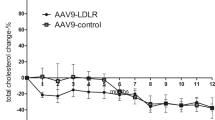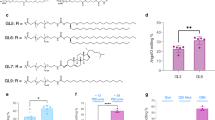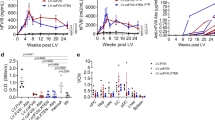Abstract
Familial hypercholesterolemia (FH) is an autosomal dominant disorder because of a mutation in the low-density lipoprotein receptor (LDLR) gene. Although lowering plasma cholesterol decreases the risk of coronary artery disease, FH patients respond poorly to pharmacologic treatment. Transferrin-facilitated intravenous transfer of a cationic liposome rabbit LDLR cDNA complex alleviated hypercholesterolemia in Watanabe Heritable Hyperlipidemic Rabbits (WHHL), an animal model of FH. Intravenous treatment dose dependently decreased plasma total and LDL cholesterol levels, correlating with an increased level of LDLR mRNA transcripts in leukocytes. Transferrin-facilitated intravenous delivery of cationic liposome LDLR gene complexes could serve as an important adjunct therapy for the treatment of FH.
This is a preview of subscription content, access via your institution
Access options
Subscribe to this journal
Receive 12 print issues and online access
$259.00 per year
only $21.58 per issue
Buy this article
- Purchase on Springer Link
- Instant access to full article PDF
Prices may be subject to local taxes which are calculated during checkout




Similar content being viewed by others
References
Ponder KP . Systemic gene therapy for cardiovascular disease. Trends Cardiovasc Med 1999; 9: 158–162.
Ishibashi S et al. Hypercholesterolemia in low density lipoprotein receptor knockout mice and its reversal by adenovirus-mediated gene delivery. J Clin Invest 1993; 92: 883–893.
Li J et al. In vivo gene therapy for hyperlipidemia: phenotypic correction in Watanabe rabbits by hepatic delivery of the rabbit LDL receptor gene. J Clin Invest 1995; 95: 768–773.
Kozarsky KF et al. In vivo correction of low density lipoprotein receptor deficiency in the Watanabe heritable hyperlipidemic rabbit with recombinant adenoviruses. J Biol Chem 1994; 269: 13695–13702.
Chowdhury JR et al. Long-term improvement of hypercholesterolemia after ex vivo gene therapy in LDLR-deficient rabbits. Science 1991; 254: 1802–1805.
Grossman M et al. Successful ex vivo gene therapy directed to liver in a patient with familial hypercholesterolaemia. Nat Genet 1994; 6: 335–341.
Lehrman S . Virus treatment questioned after gene therapy death. Nature 1999; 401: 517–518.
Marshall E . Gene therapy death prompts review of adenovirus vector. Science 1999; 286: 2244–2245.
Liu Y et al. Factors influencing the efficiency of cationic liposome-mediated intravenous gene delivery. Nat Biotechnol 1997; 15: 167–173.
Stephan DJ et al. A new cationic liposome DNA complex enhances the efficiency of arterial gene transfer in vivo. Hum Gene Ther 1996; 7: 1803–1812.
Cheng PW . Receptor ligand-facilitated gene transfer: enhancement of liposome-mediated gene transfer and expression by transferrin. Hum Gene Ther 1996; 7: 275–282.
Hara T et al. Receptor-mediated transfer of pSV2CAT DNA to a human hepatoblastoma cell line HepG2 using asialofetuin-labeled cationic liposomes. Gene 1995; 159: 167–174.
Simoes S et al. Gene delivery by negatively charged ternary complexes of DNA, cationic liposomes and transferrin or fusigenic peptides. Gene Therapy 1998; 5: 955–964.
Sato Y et al. In vivo gene delivery to tumor cells by transferrin–streptavidin–DNA conjugate. FASEB J 2000; 14: 2108–2118.
Hara T et al. Receptor-mediated transfer of pSV2CAT DNA to mouse liver cells using asialofetuin-labeled liposomes. Gene Therapy 1995; 2: 784–788.
Templeton NS et al. Improved DNA:liposome complexes for increased systemic delivery and gene expression. Nat Biotechnol 1997; 15: 647–652.
Hashida M, Nishikawa M, Yamashita F, Takakura Y . Cell-specific delivery of genes with glycosylated carriers. Adv Drug Deliv Rev 2001; 52: 187–196.
Shichiri M et al. Induction of max by adrenomedullin and calcitonin gene-related peptide antagonizes endothelial apoptosis. Mol Endocrinol 1999; 13: 1353–1563.
Shichiri M et al. Biphasic regulation of the preproendothelin-1 gene by c-Myc. Endocrinology 1997; 138: 4584–4590.
Shichiri M, Sedivy JM, Marumo F, Hirata Y . Endothelin-1 is a potent survival factor for c-Myc-dependent apoptosis. Mol Endocrinol 1998; 12: 172–180.
Cuthbert JA, Russell DW, Lipsky PE . Regulation of low density lipoprotein receptor gene expression in human lymphocytes. J Biol Chem 1989; 264: 1298–1304.
Lara LL et al. Low density lipoprotein receptor expression and function in human polymorphonuclear leucocytes. Clin Exp Immunol 1997; 107: 205–212.
de Sanctis JB, Blanca I, Bianco NE . Expression of different lipoprotein receptors in natural killer cells and their effect on natural killer proliferative and cytotoxic activity. Immunology 1995; 86: 399–407.
de Sanctis JB, Blanca I, Rivera H, Bianco NE . Expression of low-density lipoprotein receptors in peripheral blood and tonsil B lymphocytes. Clin Exp Immunol 1998; 113: 206–212.
Okazaki M, Sasamoto K, Muramatsu T, Hosaki S . Evaluation of precipitation and direct methods for HDL-cholesterol assay by HPLC. Clin Chem 1997; 43: 1885–1890.
Doi M et al. Suppression of integrin αv expression by endothelin-1 in vascular smooth muscle cells. Hypertens Res 2000; 23: 643–649.
Shichiri M, Hirata Y . Anti-angiogenesis signals by endostatin. FASEB J 2001; 15: 1044–1053.
Shichiri M et al. Genetic and epigenetic inactivation of mitotic checkpoint genes hBUB1 and hBUBR1 and their relationship to survival. Cancer Res 2002; 62: 13–17.
Acknowledgements
We thank Naohiro Zenyouji, Shibayagi Co. Ltd, for his contribution to animal studies, Shinobu H Yamaguchi, Hiroko Yasuda and Naoko Tomie for their technical help, Arbans K Sandhu, PhD and Debra L Jurmu, PhD for plasmids, and Masashi Shiomi, PhD for supplying WHHL rabbits. This work was supported in part by Grant-in-Aid for Scientific Research (B) from the Ministry of Education, Culture, Sports, Science, and Technology of Japan (AT, MS), Grant-in-Aid for Scientific Research on Priority Areas (C) Medical Genome Science from the Ministry of Education, Culture, Sports, Science, and Technology of Japan (MS), by Cardiovascular Research Fund (MS), and by Research Fund of Mitsukoshi Health and Welfare Foundation (MS).
Author information
Authors and Affiliations
Rights and permissions
About this article
Cite this article
Shichiri, M., Tanaka, A. & Hirata, Y. Intravenous gene therapy for familial hypercholesterolemia using ligand-facilitated transfer of a liposome:LDL receptor gene complex. Gene Ther 10, 827–831 (2003). https://doi.org/10.1038/sj.gt.3301953
Received:
Accepted:
Published:
Issue Date:
DOI: https://doi.org/10.1038/sj.gt.3301953
Keywords
This article is cited by
-
The Effect of PS Content on the Ability of Natural Membranes to Fuse with Positively Charged Liposomes and Lipoplexes
Journal of Membrane Biology (2005)
-
Salusins: newly identified bioactive peptides with hemodynamic and mitogenic activities
Nature Medicine (2003)



